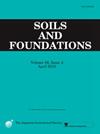The effect of suffusion on small strain shear modulus of gap-graded soil under principal stress rotation
IF 3.3
2区 工程技术
Q2 ENGINEERING, GEOLOGICAL
引用次数: 0
Abstract
Internal erosion involves the transport of soil particles from within or beneath a geotechnical structure due to seepage flow, influencing the subsequent mechanical and hydraulic behaviour of the soil. However, predicting changes in small-strain modulus () with eroded fines and varying principal stress directions can be challenging due to various factors related to soil fabric. The present study investigates the impact of seepage flow on , as well as the effect of principal stress rotation (PSR), of gap-graded soil with a fines content of 20%, using a novel erosion hollow cylindrical torsion shear apparatus. The erosion test results indicate that, regardless of density, the generally increases with seepage time. The trend of measured in the vertical and torsional directions varies significantly, as seepage is applied always downward, resulting in a different impact on the vertical and horizontal bedding planes. After a cycle of PSR, the induced torsional shear strain is found larger for the eroded specimens, while vertical strain decreases due to fine removal accompanied by seepage flow. In the PSR tests, the specimens subjected to erosion exhibit a greater reduction in compared to non-eroded specimens, with increasing the angles of principal stress direction. This reduction may be due to the inefficacy of the reinforced soil skeleton established by erosion against shearing. The distribution of fine particles and anisotropy induced by seepage flow contribute to non-trivial mechanical behaviour during principal stress rotation, particularly regarding small-strain shear modulus.
主应力旋转下淤积对间隙级配土壤小应变剪切模量的影响
内部侵蚀是指由于渗流作用,土壤颗粒从岩土结构内部或下方迁移,从而影响土壤随后的机械和水力行为。然而,由于与土壤结构相关的各种因素,预测小应变模量(Gmax)随侵蚀细粒和不同主应力方向的变化具有挑战性。本研究使用新型侵蚀空心圆柱扭剪仪,研究了渗流对细粒含量为 20% 的间隙级配土壤的 Gmax 的影响以及主应力旋转(PSR)的影响。侵蚀试验结果表明,无论密度如何,Gmax 一般都会随着渗流时间的延长而增大。由于渗流始终向下进行,因此对垂直和水平基底面的影响不同,在垂直和扭转方向测量到的 Gmax 变化趋势也大不相同。经过一个 PSR 周期后,发现侵蚀试样的诱导扭转剪切应变较大,而垂直应变则由于伴随渗流的细粒去除而减小。在 PSR 试验中,受到侵蚀的试样与未受到侵蚀的试样相比,随着主应力方向角的增大,Gmax 的减小幅度更大。这种减小可能是由于侵蚀产生的加固土壤骨架无法有效抵抗剪切力。细颗粒的分布和渗流引起的各向异性导致了主应力旋转过程中的非三维机械行为,特别是在小应变剪切模量方面。
本文章由计算机程序翻译,如有差异,请以英文原文为准。
求助全文
约1分钟内获得全文
求助全文
来源期刊

Soils and Foundations
工程技术-地球科学综合
CiteScore
6.40
自引率
8.10%
发文量
99
审稿时长
5 months
期刊介绍:
Soils and Foundations is one of the leading journals in the field of soil mechanics and geotechnical engineering. It is the official journal of the Japanese Geotechnical Society (JGS)., The journal publishes a variety of original research paper, technical reports, technical notes, as well as the state-of-the-art reports upon invitation by the Editor, in the fields of soil and rock mechanics, geotechnical engineering, and environmental geotechnics. Since the publication of Volume 1, No.1 issue in June 1960, Soils and Foundations will celebrate the 60th anniversary in the year of 2020.
Soils and Foundations welcomes theoretical as well as practical work associated with the aforementioned field(s). Case studies that describe the original and interdisciplinary work applicable to geotechnical engineering are particularly encouraged. Discussions to each of the published articles are also welcomed in order to provide an avenue in which opinions of peers may be fed back or exchanged. In providing latest expertise on a specific topic, one issue out of six per year on average was allocated to include selected papers from the International Symposia which were held in Japan as well as overseas.
 求助内容:
求助内容: 应助结果提醒方式:
应助结果提醒方式:


